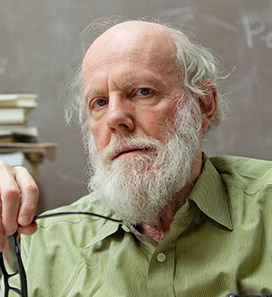
Higher exposure to air pollution is strongly associated with cognitive impairment and Alzheimer’s disease, especially for people with certain genetic risk factors for the disease. Exactly how pollution interacts with these genes to increase dementia risk is still unknown, but clues may be found in how stem cells within the brain undergo aging, according to USC researchers.

University Professor Caleb Finch is the principal investigator on a new project investigating how neural stem cells in mice age in regard to both air pollution exposure and mutations in the gene for amyloid precursor protein (APP). Michael Bonaguidi, assistant professor of stem cell biology and regenerative medicine, gerontology and biomedical engineering, is co-PI on the project. The new study is supported by a $500,000, two-year grant from the Cure Alzheimer’s Fund.
In normal aging, the brain’s stem cells multiply and proliferate less and less over time, but this decline in neural stem cell activity occurs more rapidly in Alzheimer’s disease. Pilot data for the new project indicate that mice who were exposed to air pollution also showed slower neural stem cell replication as well as increased amyloid beta protein, or Aß, which makes up the “plaques” of protein often seen in brains of Alzheimer’s patients.
Studying neural stem cells and analyzing their responses to air pollution on a single-cell basis could identify specific molecular pathways affected by pollution that lead to damage and decline as well as illuminate possible targets for treatments, Finch said. The project will also include an investigation of the effects of BPN-15606, an anti-amyloid drug developed by the Cure Alzheimer’s Fund, which appeared to protect mice against neural stem cell loss during air pollution exposure in a pilot study.
“These studies are the first to examine neural stem cell aging at the single-cell level for modulation by air pollution and for environmental interactions with amyloid peptides,” Finch said. “The findings could extend the benefits of anti-amyloid drugs and treatments to lowering environmental risks of Alzheimer’s disease.”
Finch, who holds the ARCO/William F. Kieschnick Chair in the Neurobiology of Aging at the USC Leonard Davis School of Gerontology, has studied air pollution’s effects on the brain for several years, especially the consequences of exposure to fine particulates found in pollution from automobiles, factories and more. Many studies show that air quality has a sizeable impact on cognitive health, he explained.
“As we work to understand the biology of Alzheimer’s disease and develop interventions for prevention and treatment, efforts to improve air quality will also be critical for reducing cognitive decline and Alzheimer’s,” Finch said.
